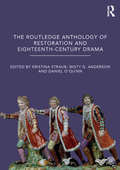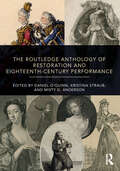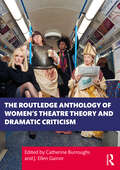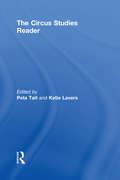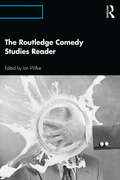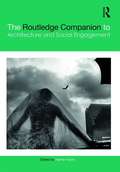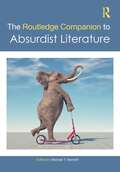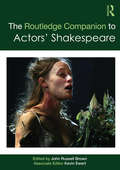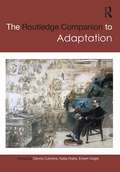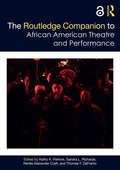- Table View
- List View
The Routledge Anthology of Restoration and Eighteenth-Century Drama
by Kristina Straub Misty G. Anderson Daniel O'QuinnThe Routledge Anthology of Restoration and Eighteenth-Century Drama brings together the work of key playwrights from 1660 to 1800, divided into three main sections: Restoring the Theatre: 1660–1700 Managing Entertainment: 1700–1760 Entertainment in an Age of Revolutions: 1760–1800 Each of the 20 plays featured is accompanied by an extraordinary wealth of print and online supplementary materials, including primary critical sources, commentaries, illustrations, and reviews of productions. Taking in the spectrum of this period’s dramatic landscape—from Restoration tragedy and comedies of manners to ballad opera and gothic spectacle—The Routledge Anthology of Restoration and Eighteenth-Century Drama is an essential resource for students and teachers alike.
The Routledge Anthology of Restoration and Eighteenth-Century Performance
by Daniel O'Quinn Kristina Straub Misty G. AndersonThe Routledge Anthology of Restoration and Eighteenth-Century Performance brings together a selection of particularly memorable performances, beginning with Nell Gwyn in a 1668 staging of Secret Love, and moving chronologically towards the final performance of John Philip Kemble's controversial adaptation of Thomas Otway's Venice Presever'd in October 1795. This volume contains a wealth of contextual materials, including contemporary reviews, portraits, advertisements, and cast lists. By privileging event over publication, this collection aims to encourage an understanding of performance that emphasizes the immediacy - and changeability - of the theatrical repertoire during the long eighteenth century. Offering an invaluable insight into the performance culture of the time, The Routledge Anthology of Restoration and Eighteenth-Century Performance is a unique, much-needed resource for students of theatre.
The Routledge Anthology of Restoration and Eighteenth-Century Performance
by Daniel O’Quinn Kristina Straub Misty G. AndersonThe Routledge Anthology of Restoration and Eighteenth-Century Performance brings together a selection of particularly memorable performances, beginning with Nell Gwyn in a 1668 staging of Secret Love, and moving chronologically towards the final performance of John Philip Kemble's controversial adaptation of Thomas Otway's Venice Presever'd in October 1795. This volume contains a wealth of contextual materials, including contemporary reviews, portraits, advertisements, and cast lists. By privileging event over publication, this collection aims to encourage an understanding of performance that emphasizes the immediacy - and changeability - of the theatrical repertoire during the long eighteenth century. Offering an invaluable insight into the performance culture of the time, The Routledge Anthology of Restoration and Eighteenth-Century Performance is a unique, much-needed resource for students of theatre.
The Routledge Anthology of Women's Theatre Theory and Dramatic Criticism
by Catherine Burroughs J. Ellen GainorThe Routledge Anthology of Women's Theatre Theory and Dramatic Criticism is the first wide-ranging anthology of theatre theory and dramatic criticism by women writers. Reproducing key primary documents contextualized by short essays, the collection situates women’s writing within, and also reframes the field’s male-defined and male-dominated traditions. Its collection of documents demonstrates women’s consistent and wide-ranging engagement with writing about theatre and performance and offers a more expansive understanding of the forms and locations of such theoretical and critical writing, dealing with materials that often lie outside established production and publication venues. This alternative tradition of theatre writing that emerges allows contemporary readers to form new ways of conceptualizing the field, bringing to the fore a long-neglected, vibrant, intelligent, deeply informed, and expanded canon that generates a new era of scholarship, learning, and artistry. The Routledge Anthology of Women's Theatrical Theory and Dramatic Criticism is an important intervention into the fields of Theatre and Performance Studies, Literary Studies, and Cultural History, while adding new dimensions to Feminist, Gender and Sexuality Studies.
The Routledge Anthology of Women's Theatre Theory and Dramatic Criticism
by Catherine Burroughs J. Ellen GainorThe Routledge Anthology of Women's Theatre Theory and Dramatic Criticism is the first wide-ranging anthology of theatre theory and dramatic criticism by women writers. Reproducing key primary documents contextualized by short essays, the collection situates women’s writing within, and also reframes the field’s male-defined and male-dominated traditions. Its collection of documents demonstrates women’s consistent and wide-ranging engagement with writing about theatre and performance and offers a more expansive understanding of the forms and locations of such theoretical and critical writing, dealing with materials that often lie outside established production and publication venues. This alternative tradition of theatre writing that emerges allows contemporary readers to form new ways of conceptualizing the field, bringing to the fore a long-neglected, vibrant, intelligent, deeply informed, and expanded canon that generates a new era of scholarship, learning, and artistry. The Routledge Anthology of Women's Theatrical Theory and Dramatic Criticism is an important intervention into the fields of Theatre and Performance Studies, Literary Studies, and Cultural History, while adding new dimensions to Feminist, Gender and Sexuality Studies.
The Routledge Circus Studies Reader
by Peta Tait and Katie LaversThe Routledge Circus Studies Reader offers an absorbing critical introduction to this diverse and emerging field. It brings together the work of over 30 scholars in this discipline, including Janet Davis, Helen Stoddart and Peta Tait, to highlight and address the field’s key historical, critical and theoretical issues. It is organised into three accessible sections, Perspectives, Precedents and Presents, which approach historical aspects, current issues, and the future of circus performance. The chapters, grouped together into 13 theme-based sub-sections, provide a clear entry point into the field and emphasise the diversity of approaches available to students and scholars of circus studies. Classic accounts of performance, including pieces by Philippe Petit and Friedrich Nietzsche, are included alongside more recent scholarship in the field. Edited by two scholars whose work is strongly connected to the dynamic world of performance, The Routledge Circus Studies Reader is an essential teaching and study resource for the emerging discipline of circus studies. It also provides a stimulating introduction to the field for lovers of circus.
The Routledge Circus Studies Reader
The Routledge Circus Studies Reader offers an absorbing critical introduction to this diverse and emerging field. It brings together the work of over 30 scholars in this discipline, including Janet Davis, Helen Stoddart and Peta Tait, to highlight and address the field’s key historical, critical and theoretical issues. It is organised into three accessible sections, Perspectives, Precedents and Presents, which approach historical aspects, current issues, and the future of circus performance. The chapters, grouped together into 13 theme-based sub-sections, provide a clear entry point into the field and emphasise the diversity of approaches available to students and scholars of circus studies. Classic accounts of performance, including pieces by Philippe Petit and Friedrich Nietzsche, are included alongside more recent scholarship in the field. Edited by two scholars whose work is strongly connected to the dynamic world of performance, The Routledge Circus Studies Reader is an essential teaching and study resource for the emerging discipline of circus studies. It also provides a stimulating introduction to the field for lovers of circus.
The Routledge Comedy Studies Reader
by Ian WilkieThe Routledge Comedy Studies Reader is a selection of the most outstanding critical analysis featured in the journal Comedy Studies in the decade since its inception in 2010. The Reader illustrates the multiple perspectives that are available when analysing comedy. Wilkie’s selections present an array of critical approaches from interdisciplinary scholars, all of whom evaluate comedy from different angles and adopt a range of writing styles to explore the phenomenon. Divided into eight unique parts, the Reader offers both breadth and depth with its wide range of interdisciplinary articles and international perspectives. Of interest to students, scholars, and lovers of comedy alike, The Routledge Comedy Studies Reader offers a contemporary sample of general analyses of comedy as a mode, form, and genre.
The Routledge Comedy Studies Reader
by Ian WilkieThe Routledge Comedy Studies Reader is a selection of the most outstanding critical analysis featured in the journal Comedy Studies in the decade since its inception in 2010. The Reader illustrates the multiple perspectives that are available when analysing comedy. Wilkie’s selections present an array of critical approaches from interdisciplinary scholars, all of whom evaluate comedy from different angles and adopt a range of writing styles to explore the phenomenon. Divided into eight unique parts, the Reader offers both breadth and depth with its wide range of interdisciplinary articles and international perspectives. Of interest to students, scholars, and lovers of comedy alike, The Routledge Comedy Studies Reader offers a contemporary sample of general analyses of comedy as a mode, form, and genre.
The Routledge Companion for Architecture Design and Practice: Established and Emerging Trends
by Mitra Kanaani Dak KopecThe Routledge Companion for Architecture Design and Practice provides an overview of established and emerging trends in architecture practice. Contributions of the latest research from international experts examine external forces applied to the practice and discipline of architecture. Each chapter contains up-to-date and relevant information about select aspects of architecture, and the changes this information will have on the future of the profession. The Companion contains thirty-five chapters, divided into seven parts: Theoretical Stances, Technology, Sustainability, Behavorism, Urbanism, Professional Practice and Society. Topics include: Evidence-Based Design, Performativity, Designing for Net Zero Energy, The Substance of Light in Design, Social Equity and Ethics for Sustainable Architecture, Universal Design, Design Psychology, Architecture, Branding and the Politics of Identity, The Role of BIM in Green Architecture, Public Health and the Design Process, Affordable Housing, Disaster Preparation and Mitigation, Diversity and many more. Each chapter follows the running theme of examining external forces applied to the practice and discipline of architecture in order to uncover the evolving theoretical tenets of what constitutes today’s architectural profession, and the tools that will be required of the future architect. This book considers architecture’s interdisciplinary nature, and addresses its current and evolving perspectives related to social, economic, environmental, technological, and globalization trends. These challenges are central to the future direction of architecture and as such this Companion will serve as an invaluable reference for undergraduate and postgraduate students, existing practitioners and future architects.
The Routledge Companion for Architecture Design and Practice: Established and Emerging Trends
by Mitra Kanaani Dak KopecThe Routledge Companion for Architecture Design and Practice provides an overview of established and emerging trends in architecture practice. Contributions of the latest research from international experts examine external forces applied to the practice and discipline of architecture. Each chapter contains up-to-date and relevant information about select aspects of architecture, and the changes this information will have on the future of the profession. The Companion contains thirty-five chapters, divided into seven parts: Theoretical Stances, Technology, Sustainability, Behavorism, Urbanism, Professional Practice and Society. Topics include: Evidence-Based Design, Performativity, Designing for Net Zero Energy, The Substance of Light in Design, Social Equity and Ethics for Sustainable Architecture, Universal Design, Design Psychology, Architecture, Branding and the Politics of Identity, The Role of BIM in Green Architecture, Public Health and the Design Process, Affordable Housing, Disaster Preparation and Mitigation, Diversity and many more. Each chapter follows the running theme of examining external forces applied to the practice and discipline of architecture in order to uncover the evolving theoretical tenets of what constitutes today’s architectural profession, and the tools that will be required of the future architect. This book considers architecture’s interdisciplinary nature, and addresses its current and evolving perspectives related to social, economic, environmental, technological, and globalization trends. These challenges are central to the future direction of architecture and as such this Companion will serve as an invaluable reference for undergraduate and postgraduate students, existing practitioners and future architects.
The Routledge Companion Of Architecture And Social Enagagement
by Farhan Karim Farhana FerdousSocially engaged architecture is a broad and emerging architectural genre that promises to redefine architecture from a market-driven profession to a mix of social business, altruism, and activism that intends to eradicate poverty, resolve social exclusion, and construct an egalitarian global society. The Routledge Companion to Architecture and Social Engagement offers a critical enquiry of socially engaged architecture’s current context characterized by socio-economic inequity, climate change, war, increasing global poverty, microfinance, the evolving notion of professionalism, the changing conception of public, and finally the growing academic interest in re-visioning the social role of architecture. Organized around case studies from the United States, Brazil, Venezuela, the United Kingdom, South Africa, Rwanda, Burkina Faso, Nigeria, Nepal, Pakistan, Iran, Thailand, Germany, Australia, Taiwan, and Japan the book documents the most important recent developments in the field. By examining diverse working methods and philosophies of socially engaged architecture, the handbook shows how socially engaged architecture is entangled in the global politics of poverty, reconstruction of the public sphere, changing role of the state, charity, and neoliberal urbanism. The book presents debates around the issue of whether architecture actually empowers the participators and alleviates socio-economic exclusion or if it instead indirectly sustains an exploitive capitalism. Bringing together a range of theories and case studies, this companion offers a platform to facilitate future lines of inquiry in education, research, and practice.
The Routledge Companion of Architecture and Social Engagement (PDF)
by Farhan Karim Farhana FerdousSocially engaged architecture is a broad and emerging architectural genre that promises to redefine architecture from a market-driven profession to a mix of social business, altruism, and activism that intends to eradicate poverty, resolve social exclusion, and construct an egalitarian global society. The Routledge Companion to Architecture and Social Engagement offers a critical enquiry of socially engaged architecture’s current context characterized by socio-economic inequity, climate change, war, increasing global poverty, microfinance, the evolving notion of professionalism, the changing conception of public, and finally the growing academic interest in re-visioning the social role of architecture. Organized around case studies from the United States, Brazil, Venezuela, the United Kingdom, South Africa, Rwanda, Burkina Faso, Nigeria, Nepal, Pakistan, Iran, Thailand, Germany, Australia, Taiwan, and Japan the book documents the most important recent developments in the field. By examining diverse working methods and philosophies of socially engaged architecture, the handbook shows how socially engaged architecture is entangled in the global politics of poverty, reconstruction of the public sphere, changing role of the state, charity, and neoliberal urbanism. The book presents debates around the issue of whether architecture actually empowers the participators and alleviates socio-economic exclusion or if it instead indirectly sustains an exploitive capitalism. Bringing together a range of theories and case studies, this companion offers a platform to facilitate future lines of inquiry in education, research, and practice.
The Routledge Companion on Architecture, Literature and The City
by Jonathan CharleyThis Companion breaks new ground in our knowledge and understanding of the diverse relationships between literature, architecture, and the city, which together form a field of interdisciplinary research that is one of the most innovative and exciting to have emerged in recent years. Bringing together a wide variety of contributors, not only writers, architectural and literary scholars, and social scientists, but graphic novelists and artists, the book offers contemporary essays on everything from science fiction and the crime novel, to poetry, comics and oral history. It is structured into two sections: History, Narrative and Genre, and Strategy, Language and Form. Including over ninety illustrations, the book is a must read for academics and students.
The Routledge Companion on Architecture, Literature and The City
by Jonathan CharleyThis Companion breaks new ground in our knowledge and understanding of the diverse relationships between literature, architecture, and the city, which together form a field of interdisciplinary research that is one of the most innovative and exciting to have emerged in recent years. Bringing together a wide variety of contributors, not only writers, architectural and literary scholars, and social scientists, but graphic novelists and artists, the book offers contemporary essays on everything from science fiction and the crime novel, to poetry, comics and oral history. It is structured into two sections: History, Narrative and Genre, and Strategy, Language and Form. Including over ninety illustrations, the book is a must read for academics and students.
The Routledge Companion to Absurdist Literature (Routledge Literature Companions)
by Michael Y. BennettThe Routledge Companion to Absurdist Literature is the first authoritative and definitive edited collection on absurdist literature. As a field-defining volume, the editor and the contributors are world leaders in this ever-exciting genre that includes some of the most important and influential writers of the twentieth century, including Samuel Beckett, Harold Pinter, Edward Albee, Eugene Ionesco, Jean Genet, and Albert Camus. Ever puzzling and always refusing to be pinned down, this book does not attempt to define absurdist literature, but attempts to examine its major and minor players. As such, the field is indirectly defined by examining its constituent writers. Not only investigating the so-called “Theatre of the Absurd,” this volume wades deeply into absurdist fiction and absurdist poetry, expanding much of our previous sense of what constitutes absurdist literature. Furthermore, long overdue, approximately one-third of the book is devoted to marginalized writers: black, Latin/x, female, LGBTQ+, and non-Western voices.
The Routledge Companion to Absurdist Literature (Routledge Literature Companions)
by Michael Y. BennettThe Routledge Companion to Absurdist Literature is the first authoritative and definitive edited collection on absurdist literature. As a field-defining volume, the editor and the contributors are world leaders in this ever-exciting genre that includes some of the most important and influential writers of the twentieth century, including Samuel Beckett, Harold Pinter, Edward Albee, Eugene Ionesco, Jean Genet, and Albert Camus. Ever puzzling and always refusing to be pinned down, this book does not attempt to define absurdist literature, but attempts to examine its major and minor players. As such, the field is indirectly defined by examining its constituent writers. Not only investigating the so-called “Theatre of the Absurd,” this volume wades deeply into absurdist fiction and absurdist poetry, expanding much of our previous sense of what constitutes absurdist literature. Furthermore, long overdue, approximately one-third of the book is devoted to marginalized writers: black, Latin/x, female, LGBTQ+, and non-Western voices.
The Routledge Companion to Actors' Shakespeare (Routledge Companions)
by John Russell BrownThe Routledge Companion to Actors’ Shakespeare is a window onto how today’s actors contribute to the continuing life and relevance of Shakespeare’s plays. The process of acting is notoriously hard to document, but this volume reaches behind famous performances to examine the actors’ craft, their development and how they engage with playtexts. Each chapter relies upon privilieged access to its subject to offer an unparalleled insight into contemporary practice. This volume explores the techniques, interpretive approaches and performance styles of the following actors: Simon Russell Beale, Sinead Cusack, Judi Dench, Kate Duchene, Colm Feore, Mariah Gale, John Harrell, Greg Hicks, Rory Kinnear, Kevin Kline, Adrian Lester, Marcelo Magni, Ian McKellen, Patrice Naiambana, Vanessa Redgrave, Piotr Semak, Anthony Sher, Jonathan Slinger, Kate Valk, Harriet Walter This twin volume to The Routledge Companion to Directors’ Shakespeare is an essential work for both actors and students of Shakespeare.
The Routledge Companion to Actors' Shakespeare (Routledge Companions)
by John Russell BrownThe Routledge Companion to Actors’ Shakespeare is a window onto how today’s actors contribute to the continuing life and relevance of Shakespeare’s plays. The process of acting is notoriously hard to document, but this volume reaches behind famous performances to examine the actors’ craft, their development and how they engage with playtexts. Each chapter relies upon privilieged access to its subject to offer an unparalleled insight into contemporary practice. This volume explores the techniques, interpretive approaches and performance styles of the following actors: Simon Russell Beale, Sinead Cusack, Judi Dench, Kate Duchene, Colm Feore, Mariah Gale, John Harrell, Greg Hicks, Rory Kinnear, Kevin Kline, Adrian Lester, Marcelo Magni, Ian McKellen, Patrice Naiambana, Vanessa Redgrave, Piotr Semak, Anthony Sher, Jonathan Slinger, Kate Valk, Harriet Walter This twin volume to The Routledge Companion to Directors’ Shakespeare is an essential work for both actors and students of Shakespeare.
The Routledge Companion to Adaptation (Routledge Companions)
by Dennis Cutchins Katja Krebs Eckart VoigtsThe Routledge Companion to Adaptation offers a broad range of scholarship from this growing, interdisciplinary field. With a basis in source-oriented studies, such as novel-to-stage and stage-to-film adaptations, this volume also seeks to highlight the new and innovative aspects of adaptation studies, ranging from theatre and dance to radio, television and new media. It is divided into five sections: Mapping, which presents a variety of perspectives on the scope and development of adaptation studies; Historiography, which investigates the ways in which adaptation engages with – and disrupts – history; Identity, which considers texts and practices in adaptation as sites of multiple and fluid identity formations; Reception, which examines the role played by an audience, considering the unpredictable relationships between adaptations and those who experience them; Technology, which focuses on the effects of ongoing technological advances and shifts on specific adaptations, and on the wider field of adaptation. An emphasis on adaptation-as-practice establishes methods of investigation that move beyond a purely comparative case study model. The Routledge Companion to Adaptation celebrates the complexity and diversity of adaptation studies, mapping the field across genres and disciplines.
The Routledge Companion to Adaptation (Routledge Companions)
by Dennis Cutchins Katja Krebs Eckart VoigtsThe Routledge Companion to Adaptation offers a broad range of scholarship from this growing, interdisciplinary field. With a basis in source-oriented studies, such as novel-to-stage and stage-to-film adaptations, this volume also seeks to highlight the new and innovative aspects of adaptation studies, ranging from theatre and dance to radio, television and new media. It is divided into five sections: Mapping, which presents a variety of perspectives on the scope and development of adaptation studies; Historiography, which investigates the ways in which adaptation engages with – and disrupts – history; Identity, which considers texts and practices in adaptation as sites of multiple and fluid identity formations; Reception, which examines the role played by an audience, considering the unpredictable relationships between adaptations and those who experience them; Technology, which focuses on the effects of ongoing technological advances and shifts on specific adaptations, and on the wider field of adaptation. An emphasis on adaptation-as-practice establishes methods of investigation that move beyond a purely comparative case study model. The Routledge Companion to Adaptation celebrates the complexity and diversity of adaptation studies, mapping the field across genres and disciplines.
The Routledge Companion to African American Art History (Routledge Art History and Visual Studies Companions)
by Eddie ChambersThis Companion authoritatively points to the main areas of enquiry within the subject of African American art history. The first section examines how African American art has been constructed over the course of a century of published scholarship. The second section studies how African American art is and has been taught and researched in academia. The third part focuses on how African American art has been reflected in art galleries and museums. The final section opens up understandings of what we mean when we speak of African American art. This book will be of interest to graduate students, researchers, and professors and may be used in American art, African American art, visual culture, and culture classes.
The Routledge Companion to African American Art History (Routledge Art History and Visual Studies Companions)
by Eddie ChambersThis Companion authoritatively points to the main areas of enquiry within the subject of African American art history. The first section examines how African American art has been constructed over the course of a century of published scholarship. The second section studies how African American art is and has been taught and researched in academia. The third part focuses on how African American art has been reflected in art galleries and museums. The final section opens up understandings of what we mean when we speak of African American art. This book will be of interest to graduate students, researchers, and professors and may be used in American art, African American art, visual culture, and culture classes.
The Routledge Companion to African American Theatre and Performance (Routledge Companions)
by Kathy A. Perkins Sandra L. Richards Renee Alexander Craft Thomas F. DeFrantzThe Routledge Companion to African American Theatre and Performance is an outstanding collection of specially written essays that charts the emergence, development, and diversity of African American Theatre and Performance—from the nineteenth-century African Grove Theatre to Afrofuturism. Alongside chapters from scholars are contributions from theatre makers, including producers, theatre managers, choreographers, directors, designers, and critics. This ambitious Companion includes: A "Timeline of African American theatre and performance." Part I "Seeing ourselves onstage" explores the important experience of Black theatrical self-representation. Analyses of diverse topics including historical dramas, Broadway musicals, and experimental theatre allow readers to discover expansive articulations of Blackness. Part II "Institution building" highlights institutions that have nurtured Black people both on stage and behind the scenes. Topics include Historically Black Colleges and Universities (HBCUs), festivals, and black actor training. Part III "Theatre and social change" surveys key moments when Black people harnessed the power of theatre to affirm community realities and posit new representations for themselves and the nation as a whole. Topics include Du Bois and African Muslims, women of the Black Arts Movement, Afro-Latinx theatre, youth theatre, and operatic sustenance for an Afro future. Part IV "Expanding the traditional stage" examines Black performance traditions that privilege Black worldviews, sense-making, rituals, and innovation in everyday life. This section explores performances that prefer the space of the kitchen, classroom, club, or field. This book engages a wide audience of scholars, students, and theatre practitioners with its unprecedented breadth. More than anything, these invaluable insights not only offer a window onto the processes of producing work, but also the labour and economic issues that have shaped and enabled African American theatre.
The Routledge Companion to African American Theatre and Performance (Routledge Companions)
by Kathy A. Perkins Sandra L. Richards Renée Alexander Craft Thomas F. DeFrantzThe Routledge Companion to African American Theatre and Performance is an outstanding collection of specially written essays that charts the emergence, development, and diversity of African American Theatre and Performance—from the nineteenth-century African Grove Theatre to Afrofuturism. Alongside chapters from scholars are contributions from theatre makers, including producers, theatre managers, choreographers, directors, designers, and critics. This ambitious Companion includes: A "Timeline of African American theatre and performance." Part I "Seeing ourselves onstage" explores the important experience of Black theatrical self-representation. Analyses of diverse topics including historical dramas, Broadway musicals, and experimental theatre allow readers to discover expansive articulations of Blackness. Part II "Institution building" highlights institutions that have nurtured Black people both on stage and behind the scenes. Topics include Historically Black Colleges and Universities (HBCUs), festivals, and black actor training. Part III "Theatre and social change" surveys key moments when Black people harnessed the power of theatre to affirm community realities and posit new representations for themselves and the nation as a whole. Topics include Du Bois and African Muslims, women of the Black Arts Movement, Afro-Latinx theatre, youth theatre, and operatic sustenance for an Afro future. Part IV "Expanding the traditional stage" examines Black performance traditions that privilege Black worldviews, sense-making, rituals, and innovation in everyday life. This section explores performances that prefer the space of the kitchen, classroom, club, or field. This book engages a wide audience of scholars, students, and theatre practitioners with its unprecedented breadth. More than anything, these invaluable insights not only offer a window onto the processes of producing work, but also the labour and economic issues that have shaped and enabled African American theatre.
